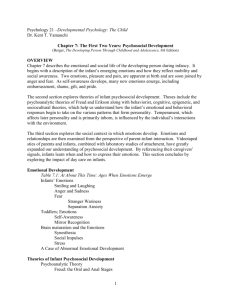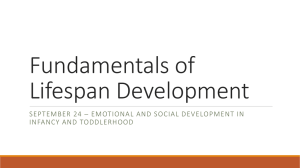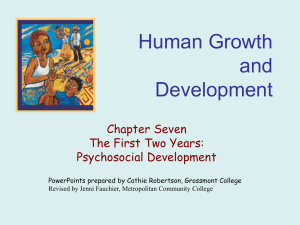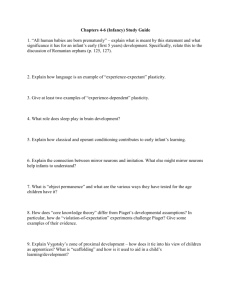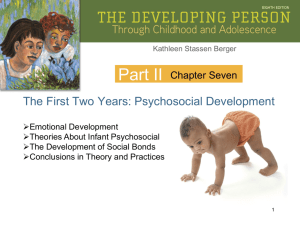File
advertisement
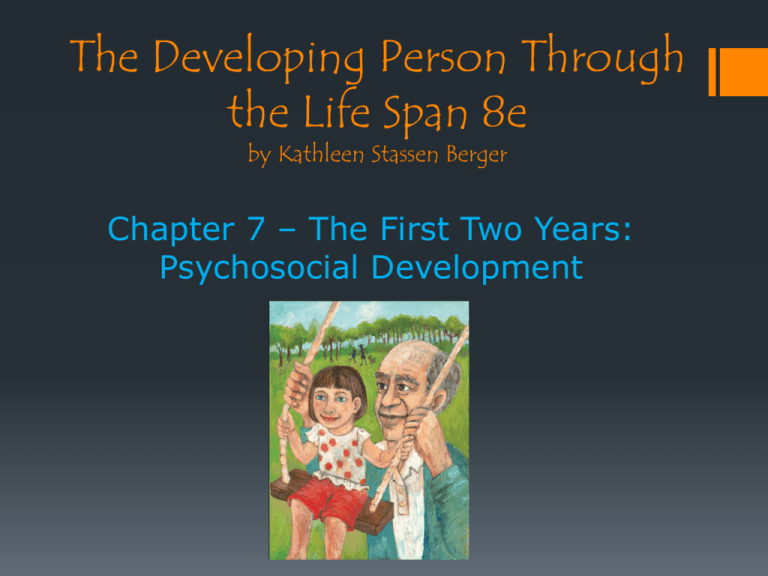
The Developing Person Through the Life Span 8e by Kathleen Stassen Berger Chapter 7 – The First Two Years: Psychosocial Development Emotional Development Infants’ Emotions Smiling and Laughing Social smile (6 weeks): Evoked by viewing human faces Laughter (3 to 4 months): Often associated with curiosity Anger First expressions at around 6 months Healthy response to frustration Emotional Development Sadness Indicates withdrawal Stressful experience for infants Fear Emerges at about 9 months in response to people, things, or situations Emotional Development Stranger wariness Infant no longer smiles at any friendly face but cries or looks frightened when an unfamiliar person moves too close Separation anxiety Tears, dismay, or anger when a familiar caregiver leaves. If it remains strong after age 3, it may be considered an emotional disorder. Emotional Development Toddlers’ Emotions – Year 2 New emotions appear: pride, shame, embarrassment, guilt Require an awareness of other people Emerge from family interactions, influenced by the culture Emotional Development Self-awareness The realization that one’s body, mind, and actions are separate from those of other people. Birth to 4 months Lack self-awareness 5 months Begin to develop an awareness of themselves as separate from their mothers. 15 to 18 months Significant development of self as a being independent of others Emotional Development Mirror Recognition M. Lewis & Brooks, 1978 Babies aged 9–24 months looked into a mirror after a dot of rouge had been put on their noses. None of those younger than 12 months old reacted as if they knew the mark was on them. 15- to 24-month-olds showed self-awareness by touching their own noses with curiosity. Social Referencing Social referencing Seeking information about how to react to an unfamiliar or ambiguous object or event by observing someone else’s expressions and reactions. Mothers use a variety of expressions, vocalizations, and gestures to convey social information to their infants. Social Impulses Particular people begin to arouse specific emotions Toddlers get angry when teased by an older sibling or react with fear when entering the doctor’s office. Memory triggers specific emotions based on previous experiences. Social Impulses Stress Impairs brain development Abuse (form of chronic stress) Potential long-term effects on a child’s emotional development Excessive stress in infants must be prevented Hypothalamus Regulates various bodily functions and hormone production May grow more slowly if an infant is often stressed Temperament Temperament • Inborn differences between one person and another in emotions, activity, and selfregulation • Temperament is epigenetic, originating in the genes but affected by child-rearing practices • Types • Easy – Difficult – Slow to warm up Attachment Attachment A lasting emotional bond that one person has with another. Attachments begin to form in early infancy and influence a person’s close relationships throughout life Infants show attachment through proximity-seeking (i.e. approaching caregiver) and contact-maintaining (i.e. touching, holding) Measuring Attachment Strange Situation A laboratory procedure for measuring attachment by evoking infants’ reactions to the stress of various adults’ comings and goings in an unfamiliar playroom. Key behaviors Exploration of the toys. A secure toddler plays happily. Reaction to the caregiver’s departure. A secure toddler misses the caregiver. Reaction to the caregiver’s return. A secure toddler welcomes the caregiver’s reappearance. Measuring Attachment Types of Attachment 1. Secure attachment 2. Insecure-avoidant attachment 3. Resistant 4. Disorganized/Disoriented Secure and Insecure Attachment Measuring Attachment Factors Affecting Attachment Opportunity Quality of caregiving Infant characteristics Parent’s internal working models Fathers as Social Partners Fathers usually spend less time with infants than mothers do and are less involved parents Reasons Fathers’ own ideas of appropriate male behavior Mothers often limit fathers’ interactions with their children Quality of marital relationship is best predictor Happier husbands tend to be more involved fathers Infant Day Care Family day care Child care that includes several children of various ages and usually occurs in the home of a woman who is paid to provide it. Center day care Child care that occurs in a place especially designed for the purpose, where several paid adults care for many children. Usually the children are grouped by age, the daycare center is licensed, and providers are trained and certified in child development. The Effects of Infant Day Care The impact of nonmaternal care depends on many factors. Psychosocial characteristics, including secure attachment, are influenced more by the mother’s warmth than by the number of hours spent in nonmaternal care. Quality of care is crucial, no matter who provides that care. Psychoanalytic Theories Freud Oral Stage 1st year Anal Stage 2nd year Erikson Trust versus Mistrust 1st year Autonomy versus Shame & Doubt 2nd year Behaviorist Theory Emotions and personality develop through reinforcement Social Learning/Modeling Accomplished by observing others Bobo clown Cognitive & Epigenetic Theories Cognitive Thoughts & values important Working model Epigenetic GENES (and that’s it!)

